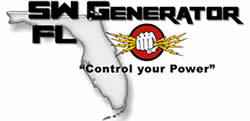Whole House Generator Troubleshooting
Whole house generators are a lifeline during power outages, ensuring your home remains powered. However, like any mechanical system, they can experience issues. Whole house generator troubleshooting can save you time and frustration. At SWFL Generator, we are southwest Florida’s premier residential and commercial generator installers. Contact us at (239) 222-1672 for professional help.
Generator Won’t Start
If your generator won’t start, there are several things to check. Start by ensuring there is enough fuel. Check the fuel gauge and add fuel if necessary. Next, inspect the battery. Ensure the battery terminals are clean and the battery is charged. If the battery is dead, replace it. Verify that the generator is in “auto” mode if it’s an automatic standby generator. If all else fails, consult your owner’s manual for troubleshooting tips or contact a professional.
Generator Starts But Won’t Stay Running
If the generator starts but then stops running, the issue could be fuel-related. Check the fuel level and ensure there are no blockages in the fuel line. Inspect the air filter and clean or replace it if necessary. A dirty air filter can cause the engine to run poorly. Additionally, check the oil level. Low oil can trigger the generator’s safety shut-off feature.
Generator Produces No Power
If your generator is running but not producing power, the problem might be the circuit breaker. Check the breaker on the generator and reset it if it has tripped. Inspect the power connections to ensure they are secure. If the generator still isn’t producing power, it might be an issue with the alternator. This is a more complex problem that typically requires professional assistance.
Overheating
Overheating is a common issue that can cause your generator to shut down. Ensure the generator is in a well-ventilated area and that the exhaust is not obstructed. Check the coolant level if your generator is liquid-cooled. Low coolant levels can cause the engine to overheat. Inspect the radiator for any blockages or damage. Clean or replace the radiator as necessary.
Excessive Noise
If your generator is making more noise than usual, it could indicate a problem. Check for loose parts or connections. Tighten any loose bolts or screws. Inspect the exhaust system for any leaks or damage. A damaged exhaust can increase noise levels. Additionally, check the vibration mounts. Worn or damaged mounts can cause excessive noise and vibration.
Frequent Shutdowns
Frequent shutdowns can be caused by various issues. Start by checking the oil and fuel levels. Low levels can trigger safety shut-offs. Inspect the air filter and clean or replace it if necessary. Ensure the generator is not overloaded. Running too many appliances at once can cause the generator to shut down. Finally, check for error codes on the generator’s display panel and refer to the owner’s manual for troubleshooting steps.
Regular Maintenance
Regular maintenance is key to preventing many common issues. Follow the manufacturer’s recommended maintenance schedule. This typically includes changing the oil and filters, inspecting the battery, and checking the fuel system. At SWFL Generator, we offer comprehensive maintenance services to keep your generator in top condition.
Professional Help
If troubleshooting doesn’t resolve the issue, it’s best to contact a professional. Attempting to fix complex problems yourself can lead to further damage. Our team at SWFL Generator is trained to handle all types of generator issues. Contact us at (239) 222-1672 for expert assistance.
Conclusion
Troubleshooting a whole house generator can be straightforward if you know what to look for. Start with basic checks like fuel, battery, and oil levels. Regular maintenance can prevent many issues from occurring. When in doubt, contact a professional for help. At SWFL Generator, we specialize in residential and commercial generator installations and maintenance. Contact us at (239) 222-1672 for professional service and peace of mind. We’re here to ensure your generator operates smoothly, keeping your home powered during outages.


